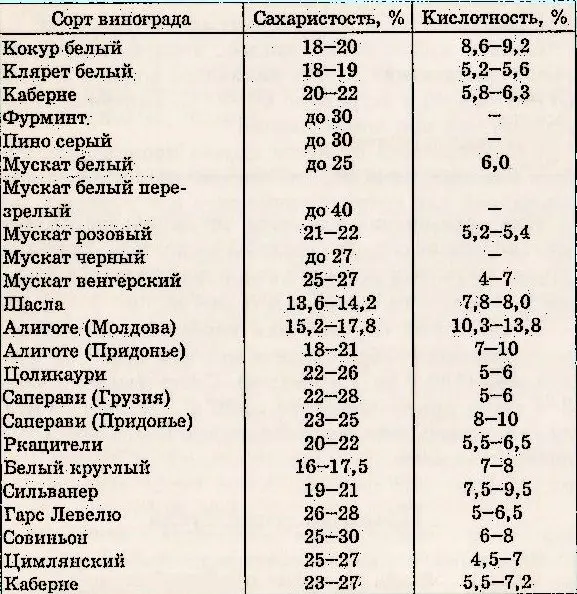Contents
Most fruit juices contain too much acid and not enough sugar. Without stabilization of the must, the wine is very acidic and not strong enough. Only some grape and apple juices do not require correction, in other cases, the intervention of the winemaker is indispensable. There are methods that allow you to normalize acidity and sugar content, minimally affecting the organoleptic properties of wine.
You can determine the initial acidity of the juice with a special device – a “pH meter” or using reference tables for the content of acids and sugar in fruits. It is advisable to use data from your region. Average data are shown in tables.


Wines with 4-6 grams of acid per liter are considered balanced. During fermentation, the concentration drops, so the initial acidity of the must is made higher – 6-15 grams per liter.
Sometimes, for example, in pear juice, it is necessary to increase the acidity of the wort. The easiest way to do this is by adding the right amount of citric acid (juice). The juice of one lemon contains 4-5 grams of acid.
Methods for reducing the acidity of wine
Attention! Reduce acidity before or during fermentation (with the exception of settling in the cold), working with the must, not the finished wine.
1. Dilution with water
The most common method used by almost all home winemakers. One drawback is that the extractivity of the wine decreases, as a result, the drink loses some of the aroma and taste.
Water reduces the acidity of the juice by half. It is important to take into account the added sugar. After dissolving 1 kg of sugar increases the volume of the wort by 0,6 liters, reducing the acidity in the same proportion as water.
Suppose there is juice with an acidity of 18 grams per liter and a sugar content of 8%. If we want to reduce the acid content to 6 g/l, we need to dilute it three times (18:6=3), that is, add 2 liters of water to 1 liter of juice. But the acid concentration also falls due to the added sugar, so its volume must be subtracted from the calculated amount of water.
1 gram of fermented sugar (natural and added) gives 0,6% alcohol in wine. To obtain wine with a strength of 12%, a total of 200 g / l of sugar is required. In the example, the volume of wort is planned to be 3 liters, to obtain a given strength, 600 grams of sugar will be required. At the same time, 80 grams is in the juice itself, which means that another 520 grams (600-80) must be added during fermentation. This sugar will occupy a volume of 0,312 liters (520 x 0,6). We reduce the amount of water by this volume (2-0,312 u1,688d XNUMX l).
Therefore, to make wine with a strength of 12% and an acidity of 0,6%, you need to add 520 grams of sugar and 1,688 liters of water to the juice with the initially set parameters. At first, the calculations seem complicated, in fact, if you understand the essence, everything is simple.
2. Blending juices
The idea is to mix acidic juice in certain proportions with other non-acidic juice, equalizing the overall acidity of the must. It is advisable to mix juices of the same fruit, but of different varieties. For example, grape with grape (red with red), apple with apple, etc. If the fruits are different, in most cases the wine is tasteless.
Unlike adding water, blending juices does not reduce the richness of the flavor, it is the best way to reduce acidity, but is rarely used in home winemaking, because it is difficult to find a suitable material for blending.
3. Introduction of acid quenchers
Adding substances to the wort that neutralize the acid. These can be special powder chemicals (used according to the instructions) or folk remedies: chalk, gypsum and eggshells.
First, the shell is washed, the film covering the egg is removed from the inside, then crumbled into small pieces. Chalk and gypsum can be laid whole or pre-crushed. Part of the wine material is poured into a separate container and mixed with an extinguisher. To neutralize 1 gram of acid, 1 gram of chalk or eggshell is required. When the precipitate falls, the juice with reduced acidity is added to the main wort (without sediment). The disadvantage of the method is that after neutralization an unpleasant odor may appear.
4. Cold
When the temperature drops to 2-4°C, acid salts precipitate. The method is used both for must and for finished wine; it can be used to reduce acidity by 1-1,5 g/l, which is very small. Cold can only fix wines with a slight excess of acid.
5. Boiling
High temperature lowers the acidity of the wine, but this method has a number of disadvantages, including: protein folding (reduced extract), the appearance of a “boiled” taste, loss of aroma, yeast death. Because of this, boiling is almost never used.









